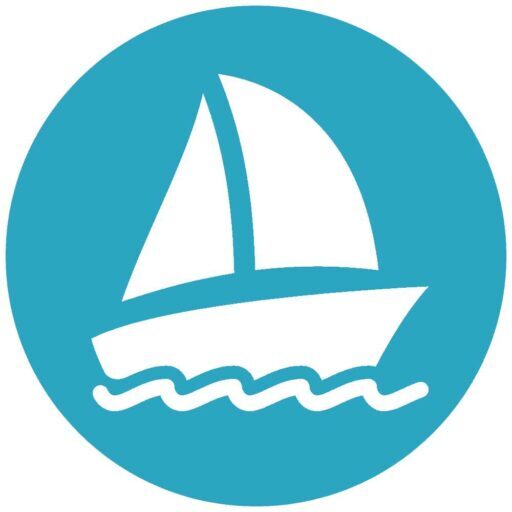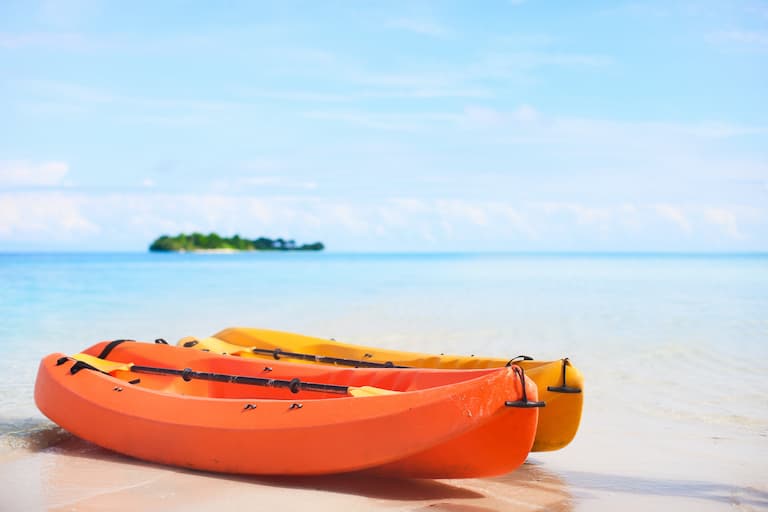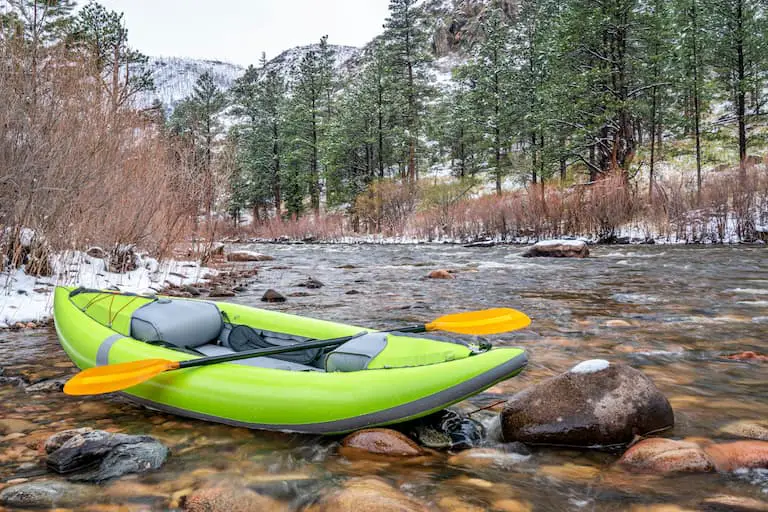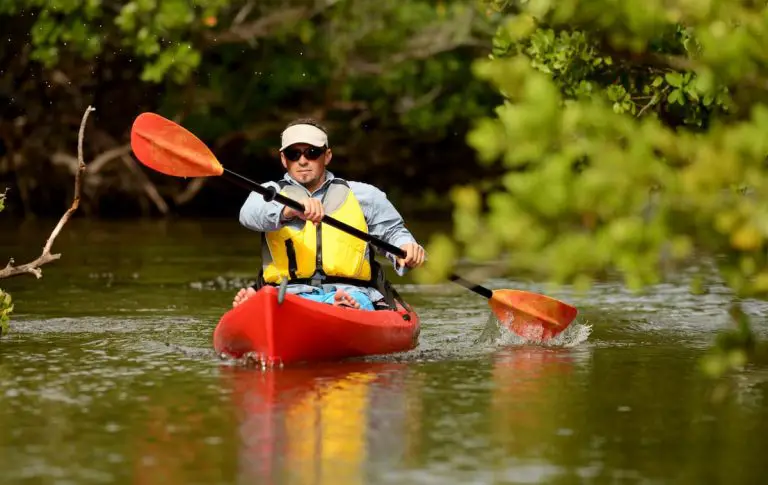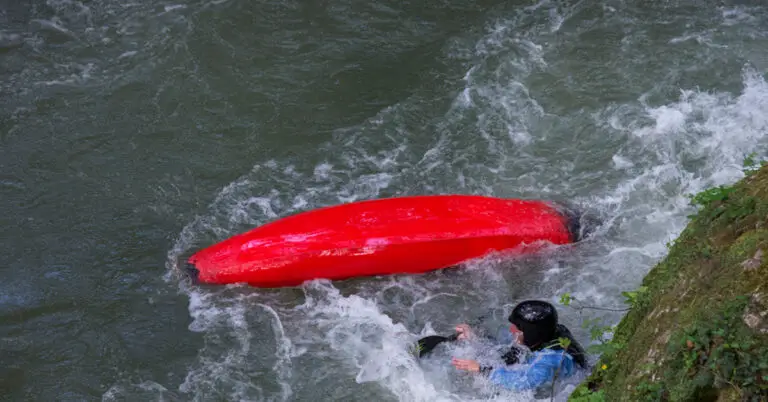How To Keep a Kayak From Drifting (10 Methods)
Like most sea vessels, your kayak is prone to drifting under the force of water currents and relatively strong winds. This can be an inconvenience, especially when carrying out fun activities that require a stable vessel, such as fishing. So what are some of the strategies you can adopt to keep your kayak stable or minimize drifting?
Here are 10 ways to keep your kayak from drifting:
- Install a drift sock.
- Deploy a sea anchor.
- Use a storm drogue.
- Install a buoy ball float.
- Attach a bungee dock and anchor line to your kayak.
- Use a kayak anchor.
- Use an anchor trolley system.
- Consider using anchor poles.
- Deploy an outrigger kit on your kayak.
- Build your expertise in balancing a kayak.
This article will explore the approaches listed above in great detail. Read on to learn about the best ways to keep your kayak steady at sea or on the lake.
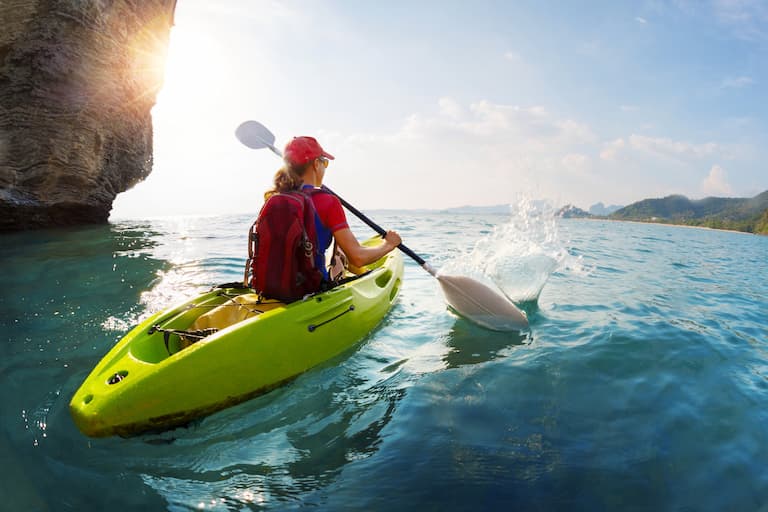
1. Install a Drift Sock on Your Kayak
A drift sock is a parachute-like bag that you can attach to a kayak, pontoon, or boat to keep it from drifting. A drift sock typically connects to your vessel via a harness, with the other end – usually a buoy or small float, then placed in the sea or lake.
The basic mechanism of a drift sock is quite simple; it creates a drag effect while in the water to reduce unwanted motion due to strong currents or winds.
Because of this drag effect, a drift sock is an effective tool to slow down the drift on a kayak or boat. This tool is also quite versatile, and you can either attach it to the front of your vessel or the rear.
In addition to helping reduce drifting, a drift sock can also be used in tandem with an anchor to help hold your vessel in position, which comes in handy when fishing or relaxing in the open sea.
Drift socks are relatively easy to access and purchase. Popular options that are available on Amazon.com include
- MOOCY Drift Sock: This product comes in various sizes ranging from 18 – 56 inches (46 – 142 cm) to match your kayak. It is portable, easy to use, and easy to stow away after use.
- MOPHOEX11 Drift Sock: This drift sock also comes in various sizes between 20 and 52 inches (51 – 132 cm) to cater to different wind conditions and boat sizes, so you can select which one works best for you.
2. Deploy a Sea Anchor on Your Kayak
A sea anchor also employs a similar mechanism as a drift sock. While they’re commonly mistaken to be the same thing, a sea anchor is different from a drift sock and is typically the costlier option. A sea anchor is set from the bow of your kayak.
Sea anchors tend to have a larger buoy when compared to the drift sock and can be used in tandem with the drift sock to help minimize drift while at sea. The main objective of a sea anchor is to stop a vessel from drifting, particularly when the vessel is moving downwind. It also helps to keep your vessel’s bow windward.
Sea anchors such as the Canyon Fishing Sea Anchor (available on Amazon.com) are also commonly deployed when you face an emergency out at sea and you want to keep your vessel from drifting into obstacles or when you want to wait out a storm.
3. Use a Storm Drogue to Prevent Kayak Drift
Drogues are cone-shaped chute-like equipment used to reduce drifting while also serving as steering assists in case of an emergency. They’re generally smaller than both sea anchors and drift socks, but like these larger devices, they create a significant enough resistance in the water to keep your kayak from drifting out into the sea.
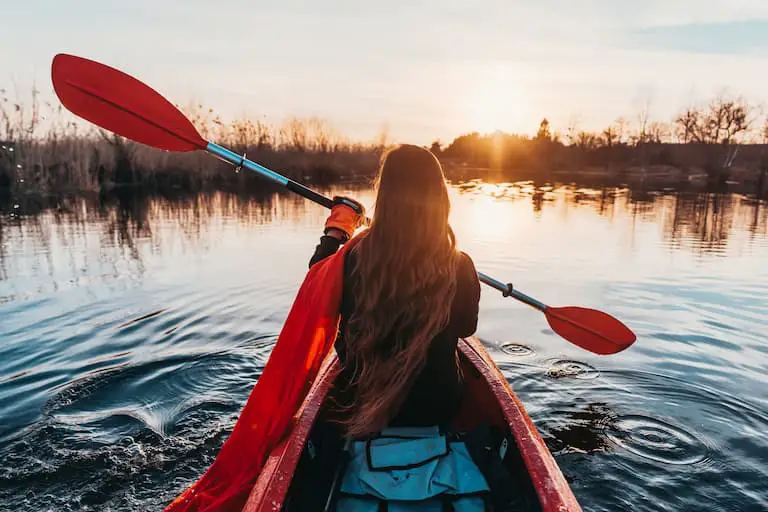
Drogues attach to the back of your kayak via a long line, slowing it down during heavy weather while also simplifying maneuverability. One of the main differences between a drogue and a sea anchor is that while a sea anchor will typically be deployed when your vessel isn’t underway, a drogue is used to enhance control when your kayak is underway.
This way, you’re still in command of your vessel when using a drogue, a luxury you don’t have when using sea anchors. A second significant difference is that while a sea anchor is intended to stop your vessel, a drogue is aimed at only slowing it down.
4. Install a Buoy Ball Float To Keep Kayak From Drifting
If parachute-like devices don’t tickle your fancy, you always have the option of other equipment such as a buoy ball float. These easy-to-install devices attach to your kayak via carabiner clips on both ends that help stabilize your vessel.
A buoy ball float typically consists of a float ball with a long nylon rope tow line. You can attach the carabiner clip to your belt or any part of your kayak. The ball float is then placed on the water, helping to stabilize your kayak.
One of the popular buoy ball float devices in the market that is available on Amazon.com is the Calidaka Buoy Ball Foat Leash. It is durable and has two stainless carabiners, making it secure and convenient to use.
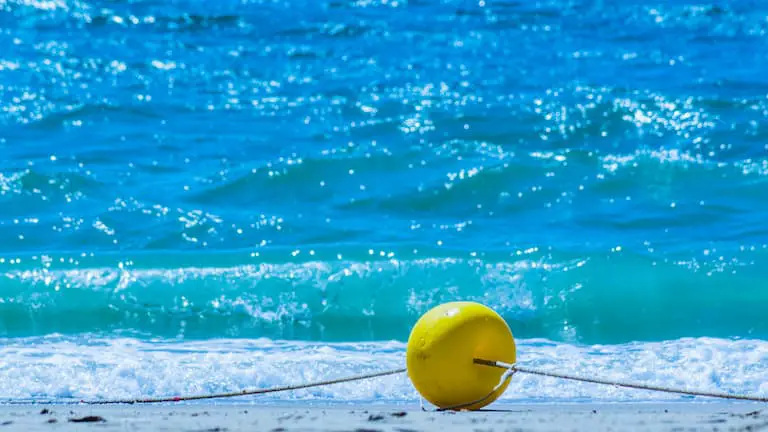
5. Attach a Bungee Dock and Anchor Line to Your Kayak
A bungee dock and anchor line is a versatile tool that helps minimize the degree of pull on your kayak or other boating vessels, especially during strong winds or currents. You can also use this equipment to complement your sea anchor by absorbing shock from ocean waves on it.
Therefore, for best results, it’s a good idea to use the dock and anchor line to complement your sea anchoring solution. This equipment is made of a bungee cord built into the ropes to prevent waves from lifting and pulling off your sea anchor.
This equipment also has a floating end that acts as a buoy and floats on the water. This end prevents the lines from sinking.
Because of their excellent mechanics and easy-to-install and straightforward design, a dock and anchor line is a suitable alternative to the traditional anchor without compromising on the degree of pull it can provide during storms or strong currents.
The Sand Shark Bungee Dock and Anchor Line is an excellent example and is available on Amazon.com. Its shock-absorbing feature prevents the hard snap that comes with other anchor lines. It also has excellent customer reviews.
6. Use a Kayak Anchor to Keep From Drifting
As explained above, a bungee dock and anchor line serve as an alternative to the traditional anchor. However, this doesn’t mean you’d completely ignore a kayak anchor. In terms of performance and helping to stabilize your vessel, a kayak anchor is still an effective solution.
Kayak anchors are lightweight equipment that are easy to carry on board and help keep your kayak in place when, say, fishing or if you want to read your favorite book or enjoy a conversation with your friends surrounded by blue sea waters.
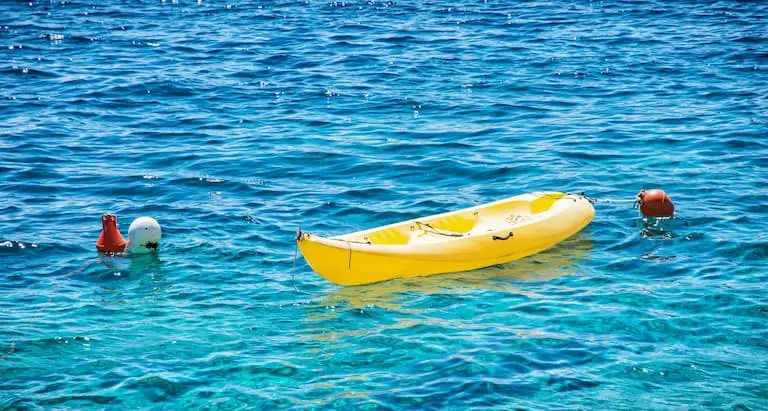
Saying that you’re spoiled for choice when it comes to kayak anchors is an understatement. There are numerous types of kayak anchors, including the following:
- Wing anchors: These kayak anchors are shaped like a digger. Because of this design and the curves under the anchor, these devices easily dig into the bottom of the surface to keep your vessel in place. They’re an effective solution for most surfaces except rocky ones.
- Plow anchors: These anchors are a lot similar to wing anchors, but the difference is that they’re sharper, making it easier to penetrate the pond bottom or lakebed. They feature a shaft that keeps the anchor upright while out in the water and are considered the better solution for keeping your kayak still.
- Claw anchors: These are the type of anchor that is best for when you want to take your kayak out on a lake. They’re best suited for the bottom of a lake. As the name suggests, they feature a long shaft and a trio of claws to penetrate the surface.
- Fluke anchors: Ideal for sandy or muddy bottom surfaces, these anchors feature a hinge mechanism, with the fluke holding the anchor down.
- Grapnel anchors: These anchors have a traditional look and feel, with three of four arms that hold on to the bottom when dropped into the water. However, these types of anchors need a latch to hold on to for them to be effective.
- Mushroom anchors: If you’re looking for an anchoring solution that holds for an extended period, then mushroom anchors are your best bet. These mushroom-shaped anchors have excellent holding power that grows stronger with debris accumulation to the bottom.
Your choice of an anchor will largely depend on the surface of the bottom, how long you want to stay in a static position, and your budget. As the anchor experts at West Marine explain, heavier anchors are preferable to lighter options to keep your kayak stationary against strong winds or current.
The gurus at West Marine also advise investing in an anchor trolley system if you plan to anchor your kayak for fishing purposes.
One of the popular options in the market is the Gradient Marine Fitness Anchor (available on Amazon.com). It is sturdy, easy to use, and rust-resistant, making it ideal for use in both freshwater and saltwater.
7. Use an Anchor Trolley System to Keep Your Kayak in Place
An anchor trolley comes in handy when you need to keep your kayak in the same position or ensure that your vessel faces your preferred direction. It is also a valuable tool to simplify retrieving the anchor from the surface or when you need to turn your kayak around without first removing the anchor.
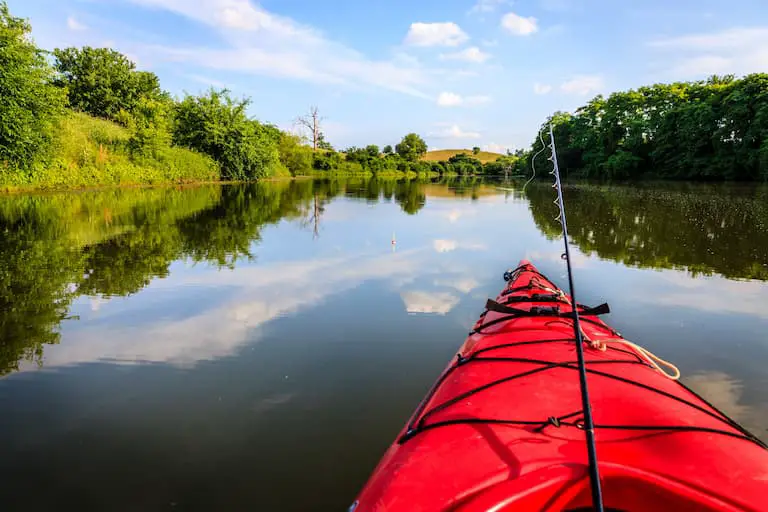
As previously discussed in the previous point on traditional anchors, you can use an anchor trolley system on its own or improve the efficiency of a conventional anchor. It’s also an ideal solution when you plan to fish in larger water bodies or bodies with strong currents because it makes it easier to attach your anchor.
An anchor trolley consists of three main parts; a pair of pulleys, a rope that passes through both pulleys, and a ring.
The YakGear Deluxe Anchor Trolley Kit is a top-rated example from Amazon. It allows easy positioning of an anchor rope to the ring, making it easy to control the kayak by manipulating the specific anchoring point.
There are also different ways of using an anchor trolley system. For instance, you can use it on one side of the kayak or both sides. Using the latter option helps to keep your kayak in the same place. If you’re fishing or kayaking on shallower waters, you can also use a stake out pole instead of an anchor.
If you don’t have a stake out pole, you can use push poles with sharp ends or long garden spikes instead to penetrate the bottom of the pond or lake and keep your kayak from drifting.
8. Consider Using Anchor Poles on Your Kayak
Anchor poles are an alternative solution to traditional anchors, which can have complex and sometimes many moving parts. These are spear-shaped poles equipped with a handle at one end.
These pieces of equipment are used to punch holes into the bottom of the lake or pond. For best results, push the pole into the water using the end with a handle to ensure stability. This solution is ideal for deployment outboard and works together with an anchor trolley system.
Anchor poles are popular for their simplicity. However, it’s essential to remember that anchor poles are best for use in shallow water. Drift anchors and drogues will serve you better for deeper waters because they’re not reliant on contact with the bottom surface.
Not sure where to start? Try out the Hobie Stakeout Pole that is available on Amazon.com. It is five feet (1.5 m) long, providing a good length for staking or movement boost in slightly deep waters.
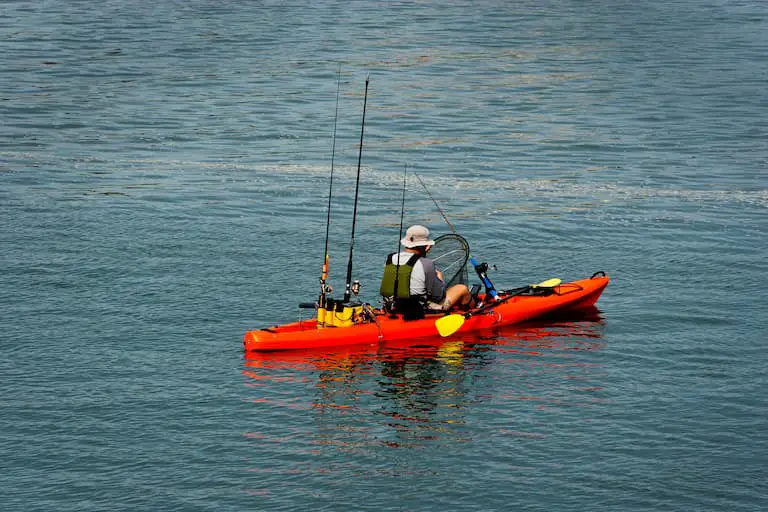
9. Deploy an Outrigger Kit on Your Kayak to Stabilize Drift
An outrigger kit is a kayak stabilizer that resembles training wheels on a bicycle. They’re a 2-piece system that you can easily attach to each side of your kayak to add stability while also improving buoyancy.
Because these stabilizers sit on either side of your kayak, they also help prevent swaying from side to side or tipping under strong winds or currents. An outrigger kit is definitely worth considering to minimize drift while also enhancing safety as an easy and quick solution to install and remove if need be.
More so, these stabilizers provide an ideal solution when you’re teaching your child how to kayak, or if you’re a newbie who has not yet mastered the art of keeping your kayak stable or using more complex systems such as anchor trolleys.
One of the popular outrigger kits in the market that are available on Amazon.com is the METER STAR Kayak Stabilizer. It is lightweight and inflatable, making it portable and easy to use. In addition to kayaks, it also works well with canoes and boats.
10. Build Your Expertise in Balancing a Kayak
While all the above tools will definitely help to minimize drift, you still need to build your balancing ability. Focusing on some crucial aspects such as body mechanics and strengthening your core can help to enhance your vessel’s stability.
However, these are skills that you need to work on and improve over time. I recommend first practicing stability while using your kayak in shallow water before taking it out to deeper, rougher waters.
Keep a Kayak From Drifting – Conclusion
There are a surprising number of ways to keep a kayak from drifting when out on a body of water. Each of the solutions above is fairly simple to use and quite cost-effective.
In addition, you can often combine multiple tools at once to ensure that your kayak doesn’t drift.
